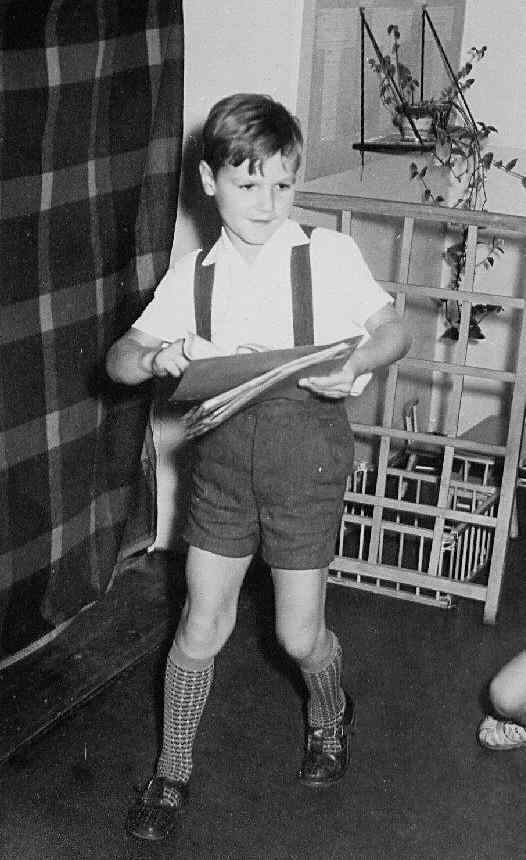
Figure 1.--Here we see a German boy at home with a book. He wears suspender shorts, kneesocks and English-style T-bar sandals. The image is undated, but was probably taken in the early 1950s. |

|
Before World War II (1939-45), the most common type of sandal worn in Germany was the single strap style without a center strap. A good example is a German boy about 1930. We also notice boys wearing the English style closed toe sandal. An example is two brothers probably about 1920. The popularity declined, however, during the NAZI era (1933-45) as it was not considered sufficiently masucline for German boyhood. One never sees, for example, a Hitler Youth boy wearing strap sandals. After the War, sandals were again worn by German boys, bout the single strap style was not as common as before the War. We do see some boys wearing the English school style with the center "T" strap. A ghood example is the boy here wearing "T"-strap English-style sandals, probablu in the 1950s (figure 1). Gradually the closed-toe style declined in popularity and we see boys wearing open-toe sandals as a kind of informal or play shoe. The closed-toe style was more likely to be worn by boys from wealthy families. I think wealthier families orientated themselves on the french style of clothing. In the 1970s children clothes from France were very popular in Germany and French sandals were more commonly the closed-toe style.
We note two basic styles of closed-toe sandals. The single bar withou center strap was most common in the early 20th century. The style with the center strap was popular for a few years after World War II. These were leather sandals, but we note a kind of gym shoe made in canvas or fabric.
Before World War II (1939-45), the most common type of sandal worn in Germany was the single strap style without a center strap. These were leather sandals. Some were for dresswear as a formal shoe. others were made as a play sandal. American advertizing did not at first use the term "sandal" in the sence of a play shoe. I am not sure about German advertizing. We notice these shoes in the early 20th century. They seen especially common for boys in the 1920s. They were most commobly worn by younger boys, but we note school age boys wearing them as well. A good example is a German boy about 1930. The popularity declined, however, during the NAZI era (1933-45) as it was not considered sufficiently masucline for German boyhood. One never sees, for example, a Hitler Youth boy wearing strap sandals. There was one exception here. We have noted Hitler Youth boys and other German boys wearing what look like strap shoes, but they seem to be a kind of gym shoe made in canvas or other material rather than ledather. They all seem to be black. We only notice these shoes in the 1920s anf 30s.
We also notice boys wearing the English style closed toe sandal. An example is two brothers probably about 1920. After the War, sandals were again worn by German boys, bout the single strap style was not as common as before the War. We do see some boys wearing the English school style with the center "T" strap. A good example is the boy here wearing "T"-strap English-style sandals, probably in the 1950s (figure 1). Gradually the closed-toe style declined in popularity and we see boys wearing open-toe sandals as a kind of informal or play shoe. Many of these sandals were made with perorations.
The closed-toe sandals were more likely to be worn by boys from wealthy families. I think wealthier families orientated themselves on the French style of clothing. In the 1970s children clothes from France were very popular in Germany and French sandals were more commonly the closed-toe style.
We notice boys wearing a variety of hosiery with closed-toe sandals. Knee socks seem quite common. This may because that sandals were most commonly worn during the summer when long-stockings were less commonly worn. And when closed-toe sandals were most common before and just after Workd War II, ankle socks were just beginning to be popular. We notice boys wearing both colored and whiye knee socks with closed-toe sandals. Quite a few boys wore white knee socks which were not at all common in England where closed-toe sandals were very commonly worn. Long stockings might be wirn for more formal occassions, but here other styles of footwear were more common such as single-bar strap shoes. The closed-toe sandal was seen as more of a casual shoe which affected the choice of hosiery. .
Navigate the Boys' Historical Clothing Sandal Pages:
[Return to Main German closed toe sandal style page]
[Return to Main German sandal page]
[Return to Main shoe page]
[Return to Main German page]
[German open toe sandals]
[German strap shoes]
Navigate the Boys' Historical Clothing Web Site:
[Return to the Main country closed-toe sandal psge]
[Introduction]
[Activities]
[Biographies]
[Chronology]
[Cloth and textiles]
[Clothing styles]
[Countries]
[Topics]
[Bibliographies]
[Contributions]
[FAQs]
[Glossaries]
[Images]
[Images]
[Links]
[Registration]
[Tools]
[Boys' Clothing Home]
